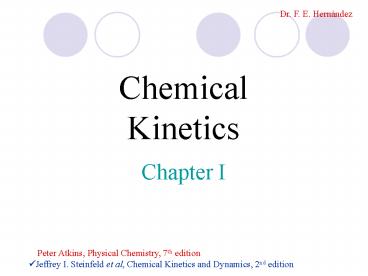Chemical - PowerPoint PPT Presentation
1 / 36
Title:
Chemical
Description:
Chemical kinetics: Study chemical systems whose composition changes with time ! ... Reaction rate for n order respect with only one reactant. e) Reaction half-lives: ... – PowerPoint PPT presentation
Number of Views:138
Avg rating:3.0/5.0
Title: Chemical
1
Dr. F. E. Hernández
Chemical Kinetics
Chapter I
Peter Atkins, Physical Chemistry, 7th
edition ?Jeffrey I. Steinfeld et al, Chemical
Kinetics and Dynamics, 2nd edition
2
Basic concepts of kinetics
- First law
- Second law
- Third law
?Thermodynamics
? Kinetics
Feasibility of any process or reacction to take
place (DSUniv. gt 0, DG lt 0)
Deal with changes of the system properties in
time. (Physical-Chemical)
a) Rate of a chemical reaction
Chemical kinetics Study chemical systems whose
composition changes with time
- Homogeneous Single-phase
- Heterogeneous Multi-phase
!Gas, liquids, solid
3
Stoichiometric representation
- ? a and b of moles of A and B, i.e. the
reactants - ? c and d of moles of C and D, i.e. the
products
aA bB ? cC dD
I2 hn ? I2 I2 ? 2I 2I M ? I2 M H2 2I ?
2HI
Irreversible Chemical reaction
Reversible Chemical reaction
2H2 O2 2H2O H2 I2 2HI
- Elementary One step
- Complexes Multi-steps
Type of reactions
Rate of reaction Change in composition of the
reaction mixtures
Reac. ? i (-)
Prod. ? j ()
4
b) Order and Molecularity of a chemical reaction
- One or more reactants
- is
Reaction rate
R f(A, B)
- One or more intermadiates
- Es
- One or more species that do not appear in the
reaction - C
R a Am Bn
- m and n Integer, fractional or negative
- m Order of reaction with respect to A.
- n Order of reaction with respect to B
- p m n Overall order of reaction
Rate equation!
R K Am Bn
Rate constant (Proportionality constant)
http//www.chem.uci.edu/education/undergrad_pgm/ap
plets/sim/simulation.htm
5
General expression
- ni Reaction order with respect to is component.
- Units of K i-(p-1)t-1
Elementary reactions are described by their
molecularity
Molecularity of reactants involved in the
reaction step! (always an integer)
? Spontaneous decomposition ? A and B
react with each other ? Three reactants that
comes together
A ? Products ? Unimolecular A B ? Products ?
Bimolecular A B C ? Products ? Termolecular
http//www.chm.davidson.edu/ChemistryApplets/kinet
ics/ReactionRates.html
6
Elementary reaction rate laws
Time behavior ? Integrating the rate law
a) Zero-Order reaction
a) A ? products
Heterogeneous reactions
At
A0
m -K
t
7
b) First-Order reaction
a 1
b) A ? products
t00
CH3NC ? CH3CN
At
logAt
A0
logA0
K-1 t (Decay time) At A0/e e2.7183
m -K/2.303
e-1A0
t
t
t
8
(CH3)3CBr H2O ? (CH3)3COH HBr 90 acetone
10 water
9
c) Second-Order reaction
c1) A A ? products
b a
2CH3 ? C2H6
b a
At-1
m 2K
A0-1
t
10
c2) A B ? products
H2 O ? OH H
b a
b a
11
d) Third-Order reaction
d1) A A A ? products
b a
I I M ? I2 M
At-2
m 6K
A0-2
t
12
d2) A A B ? products
BgtgtA B const.
O O2 M ? O3 M
Partial fractions!
13
d3) A B C ? products
Reaction rate for n order respect with only one
reactant
14
e) Reaction half-lives
Alternative method to determine the reaction order
First-order reaction
For a reaction of order ngt1 in a single reactant
This is function of A0
Independent of A0
15
1st order reaction half-lives
16
T dependence of the rate constant, K
The Arhenius equation
- i
- t
- pH (only in solution)
- ? T! (Strongly)
K(T)
lnK(T)
E
lnA
A Frequency factor
EAct(F)
EAct(R)
Reac
m -EAct/k
DH0Rxn
Prod.
T
Chemical coordinates
17
(No Transcript)
18
Determinant Parameters
Ineffective
Effective
19
Catalysis
20
Complex reactions
a) Reversible reactions
kf
A1 A2
kr
If _at_ t0 A1 A10 A2 A20
Cl
Cl
A1 A2 A10 A20
A2 A10 A20 - A1
(Mass conservation law)
21
Introducing the variable m
If _at_ t0 A200
22
When the equilibrium is reached
23
b) Consecutive reactions
k1
k2
A1 A2 A3
b1) First
b2) Second
For A2 Linear differential equation of first
order
24
Standard methods
If _at_ t0 A200
b3) Third
A10 A1 A2 A3 A3 A10 - A1
- A2
25
A
B
C
C
B
A
K1 1 K2 0.1
K1 1 K2 100
26
K1 1 K2 0.1
K1 1 K2 0.01
K1 1 K2 10
K1 1 K2 100
27
c) Parallel reactions
(First order decay to different products)
k2
A1 A2 A3
k3
c1) First
28
c2) Second
c3) Third
A30 0
A20 0
b a
b a
b a
b a
29
k2
A1 A2 A3
k3
k2 1, k310
k2 1, k31
k2 1, k30.1
30
d) Parallel reactions
k1
A1 A2 A3
k3
31
k1
A1 A2 A3
k3
k1 1, k310
k1 1, k31
k1 1, k30.1
32
Steady-State approximation
This method is very useful when intermediates are
present in small amount Ai
If we take the case b2) of Consecutive
reactions (k1 ltlt k2)
Home work!
k1
k2
A1 A2 A3
K-1
33
The Michaelis-Menten mechanism
(Enzyme action)
S (Substrate)
E (Enzyme)
X (Enzyme-Substrate complex)
E (Enzyme)
P1 P2 (Products)
True chemical Intermediate ES ltlt 1 K2 gt k1
Another Initial condition is
E0 E ES S0 S P
34
Considering S gtgt P _at_ t 0
35
t ? 0
Michaelis-Menten constant
t ? 0
v
vS
vS
2
KM
S
36
Galaxies

